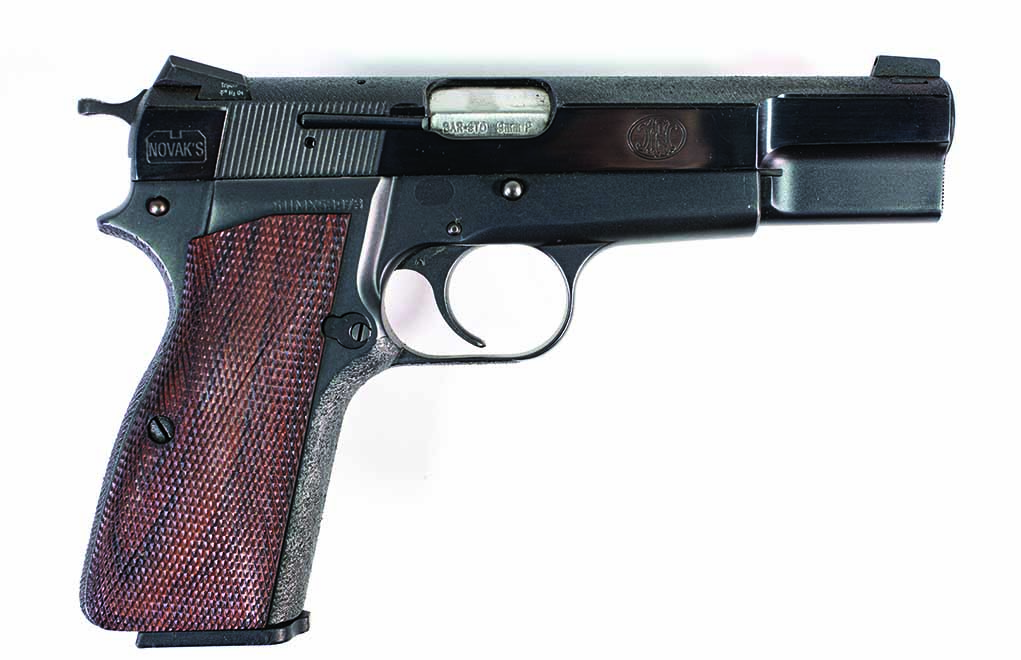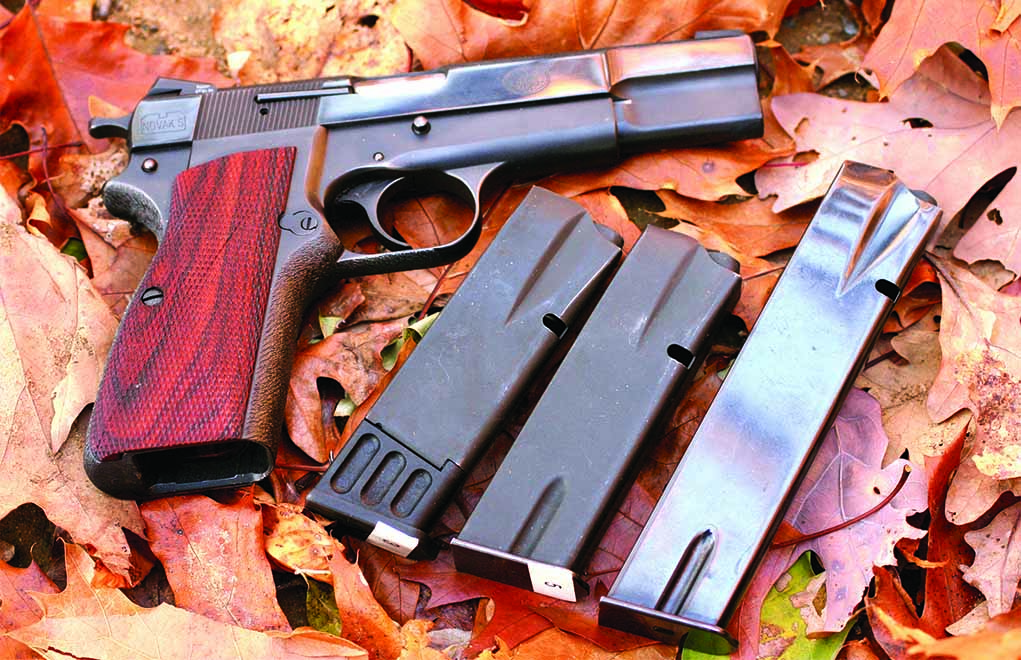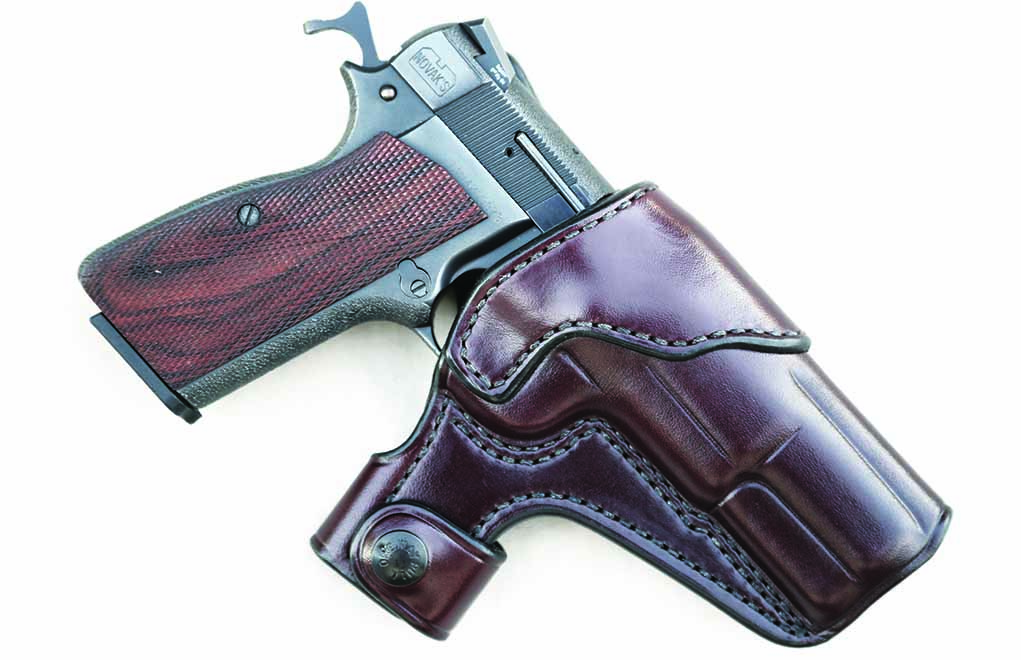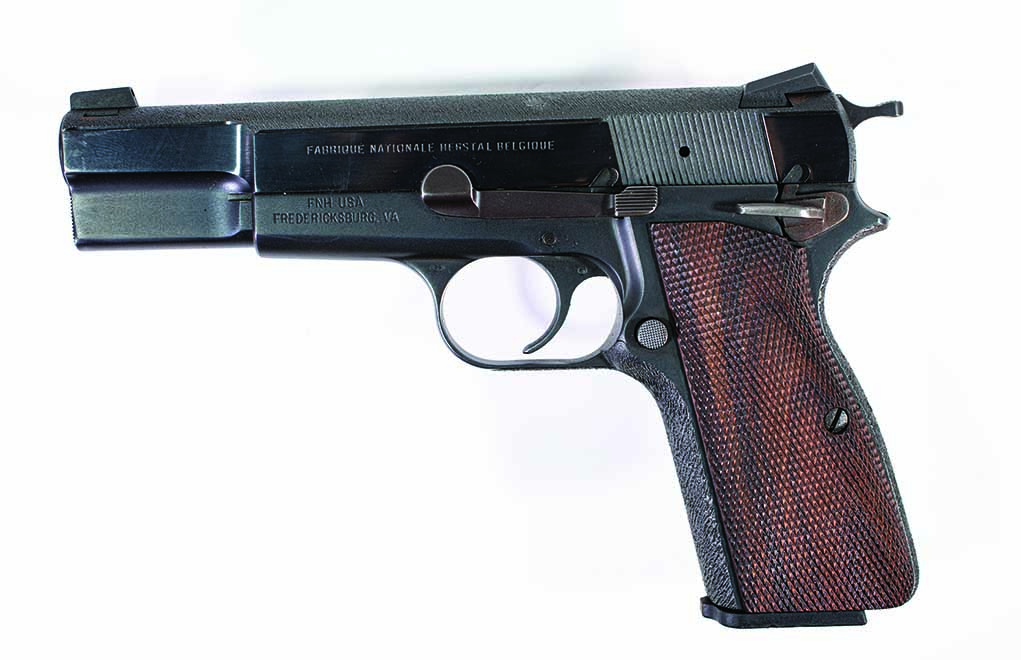

The world is not yet all polymer. Classics, such as the Browning Hi Power, have tried and true place in concealed carry.
There was a time when blued steel and walnut ruled the planet; when “plastic” meant crappy things made in Japan; and when the FBI actually trusted its agents to carry personally owned firearms.
A Tale of ‘Disappointment’
I was at work one day at The Gun Room in the very early 1980s, a storefront gun shop on Telegraph Road just a major league ball throw from the Detroit border. A woman walked in, looked around and marched up to the counter.
“I went next door, and no one was there. I heard a man’s voice in the back room.”
Next door was a florist’s shop, run by women, most or all of whom had experienced messy separations from their ex-spouses. This was not good.

Mike, another Gun Room employee, got on the phone to call the police department, and Dave (another shop employee) and one of our customers—an FBI agent—headed out the front to see what was up. I went to the back door, grabbed the nearest shop gun on the way and cracked open the back door to take a peek. All I could see was that the back door of the florist shop was open.
What I did have time to grab was a Colt Detective Special—not exactly comforting, but I figured I’d have the drop if things went badly, and I could always yank the door shut, regroup with a shotgun and re-join the “festivities” if things went past six rounds.
I saw movement, and just as I was about to push the door open some more, I realized I was looking at a brown delivery uniform. The women had gotten a delivery and had forgotten to put up the counter sign that read, “In back; back in a minute.”
Dave and the FBI agent had gone in the front door, and when the women and UPS guy came out from the back, the look they gave Dave and the agent was priceless. This was Detroit, remember, back when it was wilder than the Wild, Wild West. Our neighbor was apparently a little put out—not at armed men, but that the armed men who had come to “rescue“ her hadn’t at least brought shotguns!

What the FBI agent did have was a Browning Hi Power (this was before the FBI Hostage Rescue Teams had adopted it).
The Browning Hi Power
The FBI Hostage Rescue Team Hi Powers were built by Wayne Novak, with Wayne’s sights, stippling, reliability work (not that the Hi Power needed much, even back then) and some judicious polishing where it made things run better.
Wayne still makes Hi Powers to this spec, if you want one; and if you do, the one to have built is the MKIII—not the earlier ones. (Wayne offers a package for the MKIIIs he has on hand.)
The MKIII differs from earlier P35s in a few ways. The main one is that the frame is no longer made from a forging. Forged steel can be strong, but when you have to machine away over 90 percent of the steel from a forged lump, you can’t get too enthusiastic about high-strength alloys. The tool wear becomes prohibitive. In fact, when FN decided to make .40 S&W models, it had to go with castings, which could be made of much stronger alloys.

You can tell an MKIII from earlier models by looking at the base of the frame, where the magazine well opening is. MKIII pistols have a series of scribed lines in the direction of the muzzle to indicate their provenance.
Now, this only matters if you plan on putting a lot of ammo through your BHP. Yep, this pistol has been around so long that it has a slew of monikers—BHP, P35, Hi Power—and that’s before we get to the really old ones, such as the World War II models (the Inglis, for example).
Wayne built mine on an MKIII, and in the course of testing it and writing about it for various articles, I ended up putting 23,000 rounds through it (well, that was the count some years ago. I stopped counting. Now, it could be a few thousand higher).
In all that time, I only experienced two malfunctions. One was cartridge-caused: I was putting 400 rounds per shooting session through it, and a lot of those consisted of lead bullet reloads. (The math is grim and, had I known, I might not have said “yes” to the project. Four hundred rounds a range trip, once a week, means 57.5 weeks of nonstop shooting. Yes, I spent a year shooting that pistol!) One reloaded round had a big glob of bullet lube on the side of the case, and that meant it would not fully chamber.

The other was magazine-related: A bunch of the magazines were 20-round mags. One of those was high mileage, and the spring in it finally decided to give up. A new spring, and it was back to new.
Takeaways
So, what did I learn in a year of shooting a BHP?
First, it still bites if you aren’t careful. Wayne trims the back of the hammer to almost eliminate the bite, but if your hand is big or fleshy or your grip is really high and tight (like mine), you might get nipped. You can adjust; it just takes a bit of practice.
Second, most of the sights are archaic. One glance at period-correct sights in a Hi Power, and you’ll happily have them changed to Novaks.

Third, the factory-equipped safety is as small as the sights. The P35 dates from (you guessed it) 1935, and back then, militaries were in the habit of packing pistols with the hammer down on an empty chamber. A thumb safety was almost superfluous to them.
The good news? Better safeties can be had. The Novak HRT model comes with a better safety. Cylinder & Slide makes better safeties—and even ambi safeties—for the Hi Power. It’s a bit more involved to install than the 1911 safety, so it would be prudent to have an experienced P38 pistol smith do the work.
Some feel the P35 is not up to a diet of 9mm+P ammo. Yes, the older ones, I’d agree. The MKIIIs are better-suited to such ammo, but most people find a +P load to be more work than it’s worth, even in other pistols.
BHP Care and Feeding
Taking care of the BHP is easy. Older guns might have what is called a “hump” or “angled” feed ramp. The BHP has one angle at the start, and then, it pitches over to a different angle on the approach to the chamber. Newer models have a single-angle ramp, and the old ones can be cut to the new (and better) shape.

Recoil springs are easy; Wolff has them, and you’ll want the standard 17-pound spring. The BHP is known to be hard on springs, but at $8 per spring, is it really an onerous cost to replace it every 5,000 rounds? (Realistically, that’s at least $900 in ammo costs … and your buddy whines about spring prices?!)
The original magazines were listed as 13 rounds per, and the old information had us believing the SAS only loaded 12 rounds for reliability. Mec-Gar makes two modern magazines for the Hi Power that hold either 13 or 15 rounds and fit flush to the frame. Every pistol is different, and your hold, ammo and who-knows-what could change things. So, test and know.
Holsters
Really—you have to ask? The beauty of classics such as the Browning Hi Power is that they’ve been around for so long and produced in such numbers that anyone who makes holsters offers a holster for them.
If you’re a fan of classic leather to go with your classic pistol, Galco has all the choices. When I had my HRT pistol built, I contacted John Ralston of 5 Shot Leather to build me a carry rig. I asked for an LFA-1 (a design pioneered by Lou Alessi) and a matching spare mag pouch.

If you’re not a fan of leather (those in seriously hot and damp climates might find leather to be suffering), Kydex is the answer. Blade Tech offers a classic OWB (outside the waistband) that will stand up to hard use better than you will. And, if you want a combination of leather for comfort and Kydex for durability, CrossBreed has a number of options for you.
Old-School Gets the Job Done
Do I carry my Novak HRT Hi Power? Not really. I like it too much! I’ve written about it and would hate to have it languishing in an evidence locker—with some officer’s initials scratched into it—for years until any case against me were settled. But I do have an MKII built to much the same specs; I have no such attachment to it.

A BHP, along with a spare magazine, gives you 27 to 31 rounds of 9mm problem-solving solutions. Old-school got the job done then; it’ll get the job done now.
Oh, and the HRT Hi Powers? As far as anyone knows (those who do aren’t saying much), when they were retired from active service, replaced by 1911s, the Clinton administration had them fed into choppers and smelters ( … just one of the lesser crimes committed by that tawdry group).
Browning Hi Power Specs
Type: Locked-action, self-loading pistol
Caliber: 9×19
Capacity: 13+1 rounds
Barrel: 4.6 in.
Length: 7.75 in.
Weight: 35 oz.
Trigger: 5 lb.
Finish: Blued steel or stainless
MSRP: Price varies
Maker: Browning/FN
Novak Custom: $2,995 package, complete with pistol
Editor's Note: This article originally appeared in the 2020 Concealed Carry issue of Gun Digest the Magazine.
Bone Up On Browning:
- Browning Firearms: The 9 Best Gun Designs Ever
- Browning Buckmark Review: Timeless .22 Rimfire Pistol
- Browning Automatic Rifle: The Gun That Changed the Infantry
- Browning A5 Shotgun: The First Autoloader
- Browning Citori: The World’s Most Popular Over/Under Shotgun

Next Step: Get your FREE Printable Target Pack
Enhance your shooting precision with our 62 MOA Targets, perfect for rifles and handguns. Crafted in collaboration with Storm Tactical for accuracy and versatility.
Subscribe to the Gun Digest email newsletter and get your downloadable target pack sent straight to your inbox. Stay updated with the latest firearms info in the industry.

![Best Concealed Carry Guns In 2025 [Field Tested] Wilson Combat EDC X9S 1](https://gundigest.com/wp-content/uploads/Wilson-Combat-EDC-X9S-1-324x160.jpg)


![Best 9mm Carbine: Affordable PCCs [Tested] Ruger Carbine Shooting](https://gundigest.com/wp-content/uploads/Ruger-Carbine-Shooting-100x70.jpg)
![Best AR-15: Top Options Available Today [Field Tested] Harrington and Richardson PSA XM177E2 feature](https://gundigest.com/wp-content/uploads/Harrington-and-Richardson-PSA-XM177E2-feature-100x70.jpg)

I have a 1991 Mark III and love to shoot it and carry it in my rotation. I don’t believe that a cast frame is stronger than a forged frame. That’s the first time I have heard that claim and I don’t think it is true from my life experiences. I have been a firearms instructor in the military and civilian world for the feds and Sheriff’s Office. I just retired two years ago.
Here’s what I found in a quick search of the internet that doesn’t support your premise.
“Forged parts had a 26% higher tensile strength than the same cast parts. Forged parts had a 37% higher fatigue strength resulting in a much longer lifespan than cast parts. Cast iron only had 66% of the yield strength of forged steel, a measurement that indicates the load amount metal can hold before deforming.”
Also as it is mentioned above the Mark III had a forged frame until 1993 and many were made with the left over frames. Only the cast frames have the lines on them.
A nice article with a few corrections
Not all MK III Hi Powers feature the cast frame. The MK III Hi Power was introduced in 1989. MK III Hi Powers made between 1989 and 1993 were built with forged frames. When FN introduced the .40 S&W Hi Power in 1993, FN introduced the cast frame for extra strength and standardized on the cast frame for both the .40 S&W and the 9mm Hi Power models. It’s also likely that forged frame 9mm Hi Powers were produced past 1993 until the supply of forged frames was exhausted. FN wasted nothing.
Some early cast framed Hi Powers were produced without the grooves at the bottom of the grip frame. They can be distinguished by a Z-like casting mark inside the mag well near the top.
Thanks for the great article. It’s nice that somebody still remembers when real guns were made out of metal and only squirt guns were made from plastic.
Back in the early ’70s I had put a substantial deposit on a Browning Hi Power at Kuharsky Bros. in Erie, PA. Then with a second daughter arriving I realized our finances could not take the strain of paying off that pistol. (Teachers made $7,000. a year back then!)
To me at that time it represented the most advanced handgun I could get in the US. It was high capacity – the highest at the time – and very reliable having been proven in combat and on police forces. Today it is still a damn good handgun with nice “heft”.